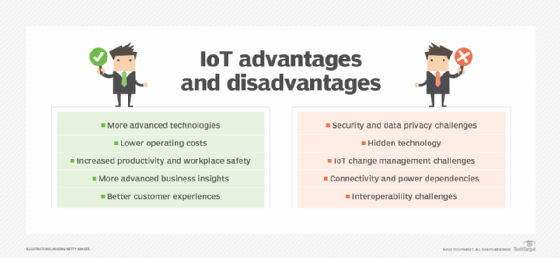Top advantages and disadvantages of IoT in business (original) (raw)
Although the use of IoT in businesses is becoming increasingly popular because of the insights it provides, the technology comes with its own risks and challenges.
The global internet of things market is estimated to grow from 662billionin2023toover662 billion in 2023 to over 662billionin2023toover3.3 trillion by 2030, as healthcare and industrial IoT use cases increase dramatically. IoT offers many benefits to businesses, including decreased operating costs, new consumer insights and opportunities to optimize business operations. It's not always a positive situation, though. Some businesses might only see the disadvantages of IoT devices and be hesitant to use them.
What are the advantages of IoT in business?
1. More advanced technologies
IoT technology has evolved significantly in the last few years. Affordable technology now exists for most use cases, making it cost-effective to deploy IoT systems at scale. That means companies take advantage of technology that does the following:
- Covers the entire spectrum of needs, from visual to acoustic.
- Contains higher-powered processing to handle increased data needs and bandwidth.
- Comes with larger storage capacities, both locally and in the cloud.
- Has longer-lasting and smaller batteries.
- Uses more advanced analytics, AI and machine learning.
2. Lower operating costs
A fleet of IoT devices can be cost-effective because it helps businesses optimize their workflows and lower operating costs by providing real-time information. Devices can proactively advise of their status so staff can schedule maintenance before it affects production. They can be integrated into larger systems to optimize operational efficiency and help reduce costs. For example, smart building systems can track, monitor and control HVAC systems to monitor building usage and make adjustments to take advantage of lower time-of-use costs, which saves money.
3. Increased productivity and workplace safety
IoT devices can manage, monitor and alert staff of changes in processes or productivity, helping them make smarter decisions about work. Automaker Ford is using specialized IoT technology and body tracking sensor technology to protect workers from excessive physical stress and to optimize their work.
Engineers and ergonomists use the data to optimize each workstation to enable more efficient movement and help workers avoid injuries. Through this novel implementation of IoT in Ford's employee safety program, it's been able to reduce assembly line injury rates by 70%.
4. More advanced business insights
IoT devices help organizations gather data to identify insights about their business, both internally and externally. Retail stores use beacon technology and other IoT devices to redesign their stores based on real-time traffic patterns. Logistics firms can use internet-connected IoT devices to align delivery locations and schedules that make the most efficient use of vehicles and employees.
Businesses that use IoT to drive modernization throughout their organization reduce their time to market for new products or services and amplify their ROI. They'll add value to the business faster and more efficiently because more actionable data from the devices is easily accessible.
5. Better customer experiences
IoT devices help businesses track, monitor, uncover and analyze customer data faster than before. Businesses can predict shifts or trends in customer behavior before they happen.
Advanced IoT technology can enhance the customer journey by personalizing it based on past experiences. Think of the location trackers on shipping vehicles or personalized coupons offered through a mobile app on customers' smartphones when they enter a store or business.
IoT devices can help businesses gather, transmit and analyze the data they have on customers, helping create a superior customer experience that engages them at a deeper level and increases customer loyalty.

IoT can provide valuable insights into the business but deploying it can be challenging.
What are the disadvantages of IoT in business?
1. Security and data privacy challenges
Although cybersecurity is a high priority, IoT devices aren't always included in the strategy. Devices must be protected from physical tampering, internet-based software attacks, network-based attacks and hardware-based attacks.
Data privacy is another concern, especially because IoT devices are being used in more sensitive industries, such as healthcare and finance. Information privacy laws are coming into effect globally, too, meaning that not only does it make good business sense to protect data, but businesses are legally required to do so.
Integrating encryption and security measures with IoT devices might be difficult with a large fleet of devices. The cost of time, effort and money to do it on all devices can be prohibitive, so some businesses might use inadequate systems because they're cheap -- or not use them at all. It only takes one breach for a business to learn a tough lesson.
2. Hidden technology
Although it might seem like IoT devices are performing simple tasks, such as counting entry swipes at a secure door, there's a lot of complex technology involved.
If those IoT devices are providing essential data to another workflow or system, they could negatively affect everything connected to it. Miscounting the number of swipes at the door isn't a big deal, but if another device confuses temperature data with entry swipe data, it could be catastrophic.
There can be a big learning curve to deploying IoT devices into any business. It makes sense to develop a strategy on how and why to deploy them before adoption. That way, businesses can be assured they're working as intended and easily supported.
3. IoT change management challenges
Companies tend to consider IoT as only a technology and don't realize the implications it has on business processes. This means they often leave implementation and maintenance exclusively to IT teams without regard to any legal, industry or internal team effects.
Truly capturing the value of IoT in a digital transformation project requires collaboration across teams and functions within a company. Only by working together can companies change people's behavior, processes and procedures while also meeting any legal and regulatory requirements.
4. Connectivity and power dependencies
Many devices depend on continuous power or internet connectivity to function properly. When either goes down, so do the devices and anything connected to them. Given how intertwined these devices are with today's businesses, everything can grind to a halt when they're down.
Businesses must understand how outages will affect their devices to plan proactively for these events -- because an outage will happen at some point. Troubleshooting and incident management processes can help alleviate that, as can ensuring that employees know how to work when the devices are down.
5. Interoperability challenges
There's currently no consensus regarding IoT protocols and standards, so devices produced by different manufacturers might not work with an existing tech stack. Each one might require different configurations and hardware connections, making efficient deployment difficult.
Businesses must understand their network to prepare for any needed customization. That also means planning for extra time on device deployments to handle any troubleshooting or related tasks that might arise.
Summary of advantages and disadvantages of IoT
IoT devices can be useful to businesses today, but only if you know what you're getting into. And these are just some of the benefits and disadvantages to them. With a little planning, you'll have a better idea of what you need and how IoT devices can help.
Next Steps
6 IoT architecture layers and components explained
Why IT admins should care about IoT in the enterprise
7 top IoT security challenges and how to overcome them
 How to spot a card skimmer
How to spot a card skimmer  By: Ava DePasquale
By: Ava DePasquale  HTML5 mobile app
HTML5 mobile app  By: Rahul Awati
By: Rahul Awati  digital wallet
digital wallet  By: Kinza Yasar
By: Kinza Yasar  Huawei MateBook E Windows tablet (laptop)
Huawei MateBook E Windows tablet (laptop)  By: Adrian Bridgwater
By: Adrian Bridgwater